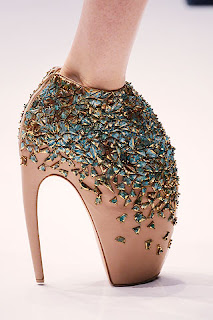Texture
This dress exudes a variety of textures ranging from the ridging on the sleeves and the bottom of the dress to the silkiness of the base of the dress. The texture of the dress varies in different parts which makes the dress much more interesting to look at than if the entire dress was the same texture. It gives the dress depth and a diversity layers that really adds to the dress.
Color
This dress immediately screams a pop of color when the viewer first sees it. The unique orange/red color of the dress sets it apart from other "normal" dresses and helps make it stand out from the rest significantly. If this dress was not a bright color, I don't think it would have the same "shock" effect that it has on the viewer that it has now. Color in this sense took a large role in establishing this dress to be a strong fashion statement.
Shape
This Alexander McQueen shoe uses shape as a method of identification. many of Alexander McQueen's shoes have the same shape which allows consumers to recognize his line much more easily. Upon first look, the shape of the heel looks unbearable to wear although they are seen on the runway. The shape of the shoe alone is a statement, without even taking the extravagant jewels into consideration.









